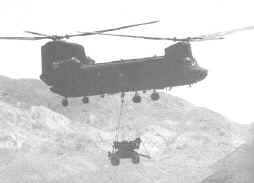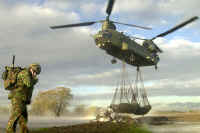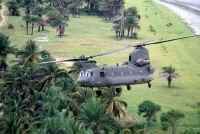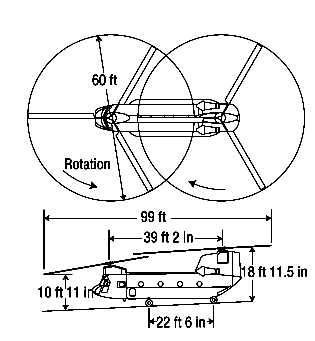 |
|
|||
|
|
||||
|
The CHINOOK |
 |
The troops call this heavy lift, do anything, do everything work-horse "the chook". (That is Aussie for chicken) It will air-lift some heavy support in the shape of a 105mm howitzer or transport a load of food and ammo or move a heap of troops, about 30, into or out of a hotspot. |
| At the time of Australia's commitment in SVN neither the RAAF nor the Australian Army had any Chinook helicopters. The US Army supplied Chinooks to the Australian Task Force as required. |
|
The Boeing CH-47 Chinook is a twin-turbine, tandem-rotor, heavy-lift transport helicopter. Boeing in Philadelphia manufactures, modernizes and supports the Chinook for the United States Army, Army Reserve, National Guard and several international customers. The
Chinook's principal U.S. Army mission is movement of troops,
artillery, ammunition, fuel, water, barrier materials, supplies and equipment on the
battlefield. Secondary
missions include medical evacuation, aircraft recovery, fire
fighting, parachute drops,
heavy construction, civil development, disaster relief and search
and rescue. In the U.S. The U.S. Army has operated a variety of CH-47 Chinook models since first taking delivery in 1962. Shortly after entering Army service, Chinooks were deployed to Vietnam, where CH-47A, B and C models served with distinction for a decade until the war's end in 1975. Of the nearly 750 Chinooks in the U.S. and Republic of Vietnam fleets, about 200 were lost in combat or wartime operational accidents. After the war, Boeing and the Army began planning a major fleet upgrade that led to development of the CH-47D. Almost 500 early model Chinooks went through an extensive modernization process in Philadelphia that produced an essential new CH-47 fleet. Boeing completed first D-model deliveries in 1982 and concluded the program in 1994. Only two U.S. Army CH-47Ds were built to replace aircraft losses in the Persian Gulf War. All other D models are modernized aircraft. The CH-47D remains the U.S. Army standard and features composite rotor blades, an improved electrical system, modularised hydraulics, triple cargo hooks, avionics and communication improvements and more powerful engines that can handle a 25,000-pound useful load, nearly twice the Chinook's original lift capacity. The CH-47D Chinook already has been the U.S. Army's prime mover for 20 years, and was a central element in U.S. Army operations in the Persian Gulf War, where more than 160 Chinooks carried U.S. and Allied troops in history's largest aerial assault to outflank Iraqi forces and cut off their retreat from Kuwait. In the mid-1990s, Boeing and the Army agreed that the Chinooks fleet should undergo a second modernization program. This will extend CH-47 service well beyond 2030, virtually guaranteeing that Chinooks will handle U.S. Army missions for at least 75 years. Boeing is currently developing the CH-47F, scheduled for first production in 2004, and is under contract to modernize at least 300 Chinooks to the new F-model standard, which features reduced vibration effects, an integrated cockpit control system and more powerful engines with digital fuel controls. These improvements will make the Chinook fully compatible with 21st century operational and war-fighting requirements and improve the aircraft's efficiency and effectiveness. U.S. Army Special Operations Forces also operate 36 Special Operations Chinooks, designated as MH-47Ds and MH-47Es. The MH-47Es are among the most advanced rotorcraft in operation today. They incorporate fully integrated digital cockpits; forward-looking infrared, terrain-following and/or terrain-avoidance radar; long-range fuel tanks; and aerial refuelling capability. Special Operations Chinooks perform low-level, high-speed flight for infiltration and exfiltration of Special Operations teams at night and in adverse weather. Boeing and the U.S. Special Operations Command are currently discussing a Special Operations Chinook upgrade program that will provide a fleet-wide common avionics suite and several other system improvements.
|



